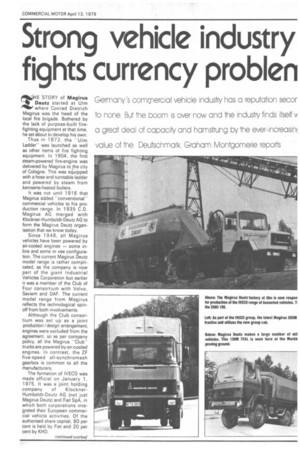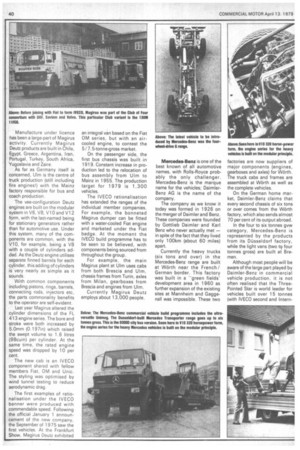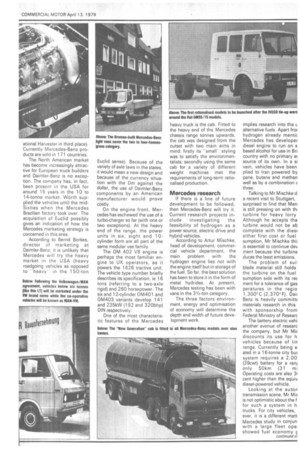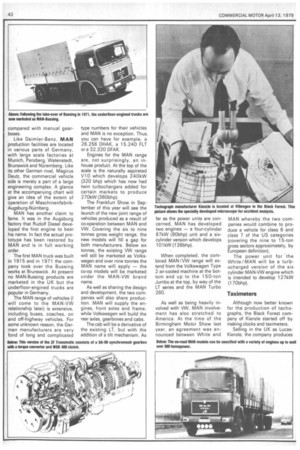Strong vehicle industry fights currency problen
Page 41

Page 42

Page 43

Page 44

Page 45

If you've noticed an error in this article please click here to report it so we can fix it.
t'HE -STORY of Magirus Deutz started at Ulm where Conrad Dietrich Magirus was the head of the local fire brigade. Bothered by the lack of purpose-built firefighting equipment at that time, he set about to develop his own.
Thus in 1872, the "'Ulm Ladder" was launched as well as other items of fire fighting equipment. In 1904, the first steam-powered fire-engine was delivered by Magirus to the city of Cologne. This was equipped with a hose and turntable ladder and powered by steam from , kerosene-heated boilers.
It was not until 1916 that Magirus added "conventional" commercial vehicles to his production range. In 1935 C.D. Magirus AG merged with Klockner-Humboldt-Deutz AG to form the Magirus Deutz organisation that we know today.
Since 1948, all Magirus vehicles have been powered by air-cooled engines — some inline and some in vee configuration. The current Magirus Deutz model range is rather complicated, as the company is now part of the giant Industrial Vehicles Corporation but earlier it was a member of the Club of Four consortium with Volvo, Saviem and DAF. The current model range from Magirus reflects the technological spinoff from both involvements.
Although the Club consortium was set up as a joint production/design arrangement, engines were excluded from the agreement, so as per company policy, all the Magirus "Club" trucks are powered by air-cooled engines. In contrast, the ZF five-speed all-synchromesh gearbox is common to all the manufacturers.
The formation of IVECO was made official on January 1, 1975. It was a joint holding
company of KlocknerHumboldt-Deutz AG (not just Magirus Deutz) and Fiat SpA, in which both corporations integrated their European commercial vehicle activities. Of the authorised share capital, 80 per cent is held by Fiat and 20 per cent by KHD.
Manufacture under licence has been a large-part of Magirus activity. Currently Magirus Deutz products are built in Chile, Egypt, Greece, Argentina, Iran, Portugal, Turkey, South Africa, Yugoslavia and Zaire, As far as Germany itself is concerned, Ulm is the centre of truck production (still including fire engines!) with the Mainz factory responsible for bus and coach production.
The vee-configuration Deutz engines are built on the modular system in V6, V8, V10 and V12 form, with the last-named being for stationary generators rather than for automotive use. Under this system, many of the components are common, with the V10, for example, being a V8 with a couple of cylinders added. As the Deutz engine utilises separate finned barrels for each cylinder, this adding of is very nearly as simple as it sounds.
With common components including pistons, rings, barrels, connecting rods, injectors etc, the parts commonality benefits to the operator are self-evident.
Last year Magirus altered the cylinder dimensions of the FL 413 engine series. The bore and stroke were both increased by 5.0mm (0.197in) which raised the swept volume to 1.6 litres (98cuin) per cylinder. At the same time, the rated engine speed was dropped by 10 per cent.
The new cab is an IVECO component shared with fellow members Fiat, OM and Unic. The styling was optimised by wind tunnel testing to reduce aerodynamic drag.
The first examples of rationalisation under the IVECO banner were produced with commendable speed. Following the official January 1 announcement of the new company, the September of 1975 saw the first vehicles. At the Frankfurt Show, Magirus Deutz exhibited an integral van based on the Fiat OM series, but with an aircooled engine, to contest the 5/7.5-tonne-gross market.
On the passenger side, the first bus chassis was built in 1919. Constant increase in production led to the relocation of bus assembly from Ulm to Mainz in 1955. The production target for 1979 is 1,300 vehicles.
The IVECO rationalisation has extended the ranges of the individual member companies. For example, the bonneted Magirus dumper can be fitted with a water-cooled Fiat engine and marketed under the Fiat badge. At the moment the IVECO build programme has to be seen to be believed, with components being sourced from throughout the group.
For example, the main Magirus plant at Ulm uses cabs from both Brescia and Ulm, chassis frames from Turin, axles from Milan, gearboxes from Brescia and engines from Ulm.
Currently Magirus Deutz employs about 13,000 people. Mercedes-Benz is one of the best known of all automotive names, with Rolls-Royce probably the only challenger. Mercedes-Benz is the marque name for the vehicles; DaimlerBenz AG is the name of the company.
The company as we know it today was formed in 1926 on the merger of Daimler and Benz. These companies were founded by Gottlieb Daimler and Karl Benz who never actually met — in spite of the fact that they lived only 100km (about 60 miles) apart.
Currently the heavy trucks (six tons and over) in the Mercedes-Benz range are built at Worth near the French/ German border. This factory was built in a -green fields' development area in 1960 as further expansion of the existing sites at Mannheim and Gaggenall was impossible. These two
factories are now suppliers of major components (engines, gearboxes and axles) for Worth. The truck cabs and frames are assembled at Worth as well as The complete vehicles.
On the German home market, Daimler-Benz claims that every second chassis of six tons or over comes from the Worth factory, which also sends almost 70 per cent of its output abroad.
In the four to six tonnes gvw category, Mercedes-Benz is represented by the products from its Dusseldorf factory, while the light vans (two t9 four tonnes gross) are built at Bremen.
Although most people will be aware of the large part played by Daimler-Benz in commercial vehicle production, it is not often realised that the ThreePointed Star is world leader for vehicles built over 15 tonnes (with IVECO second and Intern
ational Harvester in third place). Currently Mercedes-Benz products are sold in 171 countries.
The North American market has become increasingly attractive for European truck builders and Daimler-Benz is no exception. The company has, in fact, been present in the USA for around 15 years in the 10 to 14-tonne market. WOrth supplied the vehicles until the midSixties when the Mercedes Brazilian factory took over. The acquisition of Euclid possibly gives an indication of how the Mercedes marketing strategy is concerned in this area.
According to Bernd Borkes, director of marketing at Daimler-Benz, it is unlikely that Mercedes will try the heavy market in the USA (heavy roadgoing vehicles as opposed to "heavy— in the 150-ton
Euclid sense). Because of the variety of axle laws in the states, it would mean a new design and because of the currency situation with the Dm against the dollar, the use of Daimler-Benz components by an American manufacturer would prove costly.
On the engine front, Mercedes has eschewed the use of a turbo-charger so far (with one or two exceptions). At the heavy end of the range, the power units in six, eight and 10cylinder form are all part of the same modular vee family.
The OM 402 V8 engine is perhaps the most familiar engine to UK operators, as it powers the 1626 tractive unit. The vehicle type number briefly describes its specification, ie 16 tons (referring to a two-axle rigid) and 260 horsepower. The six and 12-cylinder 0M401 and 0M403 variants develop 141 and 235kW (192 and 320bhp) DIN respectively.
One of the most characteristic features of the Mercedes heavy truck is the cab. Fitted to the heavy end of the Mercedes chassis range tonnes upwards, the cab was designed from the outset with two main aims in mind: firstly its "small" styling was to satisfy the environmentalists; secondly using the same cab for a variety of different weight machines met the requirements of long-term rationalised production.
Mercedes research
If there is a line of future development to be followed, then Mercedes-Benz will try it. Current research projects in clude investigating the feasibility of hydrogen as a power source, electric drive and hybrid vehicles.
According to Artur Mischke, head of development, commercial vehicle department, the main problem with the hydrogen engine lies not with the engine itself but in storage of the fuel. So far, the best solution has been to store it in the form of metal hydrides. At present, Mercedes testing has been with vans in the 31/2-ton category.
The three factors environment, energy and optimisation of economy will determine the depth and width of future development work. implies research into the L alternative fuels. Apart froi hydrogen already rnentic Mercedes has develope( diesel engine to run on s based alcohol for use in Bri country with no primary ei source of its own. In a si vein, vehicles have been plied to Iran powered by pane, butane and methan well as by a combination ( three.
Talking to Mr Mischke d a recent visit to Stuttgart, surprised to find that Men( is still pressing on with th. turbine for heavy lorry Although he accepts tha turbine would not be ab complete with the dies( either first cost or fuel sumption, Mr Mischke thii is essential to continue deN, ment because the turbine duces the least emissions.
The problem of sui• blade material still holds the turbine on the fuel sumption side with its rec merit for a tolerance of gas peratures in the regio 1,300C (2,370F). Dail Benz is heavily committ( materials research in this with sponsorship from Federal Ministry of Researc The battery electric vehi another avenue of researc the company, but Mr Mi( discounts its use for h vehicles because of lin range. Currently being e ated in a 16-tonne city but system requires a 2,00 (39cwt) battery for a rani only 50km (31 m Operating costs are also 3i cent higher than the equiv diesel-powered vehicle.
Looking at the auton transmission scene, Mr WE is not optimistic about the f for such a system in h trucks. For city vehicles, ever, it is a different matt Mercedes study in conjun with a large fleet ope showed fuel economy c
continued o■
compared with manual gearboxes.
Like Daimler-Benz, MAN production facilities are located in various parts of Germany, with large scale factories at Munich, Penzberg, Watenstedt, Brunswick and Nuremberg. Like its other German rival, Magirus Deutz, the commercial vehicle side is merely a part of a large engineering complex. A glance at the accompanying chart will give an idea of the extent of operation of MaschinenfabrikAugsburg-Nurnberg.
MAN has another claim to fame. It was in the Augsburg factory that Rudolf Diesel developed the first engine to bear his name. In fact the actual prototype has been restored by MAN and is in full working order.
The first MAN truck was built in 1915 and in 1971 the company took over the Bussing works at Brunswick. At present no MAN-Bussing products are marketed in the UK but the underfloor-engined trucks are popular in Germany.
The MAN range of vehicles (I will come to the MAN-VW relationship later) is extensive, including buses, coaches, on and off-highway vehicles. For some unknown reason, the German manufacturers are very fond of long and complicated
type numbers for their vehicles and MAN is no exception. Thus. you can have for example, a 26.256 DHAK, a 15.240 FLT or a 32.320 DFAK.
Engines for the MAN range are, not surprisingly, an inhouse product. At the top of the scale is the naturally aspirated V10 which develops 240kW (320 bhp) which has now had twin turbochargers added for certain markets to produce 270kW (360bhp).
The Frankfurt Show in September of this year will see the launch of the new joint range of vehicles produced as a result of co-operation between MAN and VW. Covering the six to nine tonnes gross weight range, the new models will fill a gap for both manufacturers. Below six tonnes, the existing VW range will still be marketed as Volkswagen and over nine tonnes the MAN name will apply — the co-op models will be marketed under the MAN-VW brand name.
As well as sharing the design and development, the two companies will also share production. MAN will supply the engines, front axles and frame, while Volkswagen will build the rear axles, gearboxes and cabs.
The cab will be a derivative of the existing LT, but with the addition of a tilt mechanism. As far as the power units are concerned, MAN has developed two engines — a four-cylinder 67kW (90bhp) unit and a sixcylinder version which develops 101kW (136bhp).
When completed, the combined MAN/VW range will extend from the Volkswagen Type 2 air-cooled machine at the bottom end up to the 150-ton Jumbo at the top, by way of the LT series and the MAN Turbo 280.
As well as being heavily involved with VVV, MAN involvement has also stretched to America. At the time of the Birmingham Motor Show last year, an agreement was announced between White and MAN whereby the two companies would combine to produce a vehicle for class 6 and class 7 of the US categories (covering the nine to 15-ton gross sectors approximately, by European definition).
The power unit for 'the White/MAN will be a turbocharged version of the six cylinder MAN-VW engine which is intended to develop 127kW (170bhp).
Taximeters
Although now better known for the production of tachographs, the Black Forest company of Kienzle started off by making clocks and taximeters.
Selling in the UK as LucasKienzle, the company produces around 30,000 tachographs per year from its Villengen factory. Because of the accuracy requirement of a tachograph — 'far 'very obvious reasons — about one-third of the workforce is employed in quality control.
Currently around 70 to 80 per cent of tacho production goes directly to the vehicle manufacturers, with the remainder going to Kienzle service stations throughout Europe. To cope with the multitude of base models and their derivatives, Kienzle has to produce a number of different gearbox connections to satisfy the world market — at the time of writing this number is 61!
As a spin-off from the tachograph side, Kienzle has developed the Fleet Organisation System. As the name suggests, this is a vehicle cost and performance accounting programme based on results obtained. from Kienzle tachograph charts.
Known as the Kienzle IP 1613, the actual hardware consists of a computer, a read-out unit and a scanner. The scanner works on a new type of optoelectronic reading principle. The traces on the tachograph chart are broken down during scan, ning into 1,440,000 dots, which are then turned into a data map.
At the print-out stage, the system can provide full details of the operation in an easily read form, including driving time, duty time, average speed, distance and so on.
Kienzle is in the recording business, so it should come as no surprise to learn that the company also makes electronic temperature recorders for fridge vans. The Kienzle TSE recorder automatically plots the internal temperature throughout a 24hour period on a similar principle to that of a tachograph.
The temperature range which can be accommodated is between —30' and +20C (-22°F to +68°F) and Kienzle claims that the quartz clock in the recorder is accurate to plus or minus seven seconds in 24 hours.
The TSE recorder is available in three versions: a 24-hour chart recording, an eight-day recording using a stack of eight 24-hour charts and a 32-day version using eight four-day• charts.
I have deliberately avoided the area of transmissions so far, as this is summed up for the majority of German-built vehicles by talking about Zahnradfabrik Friedrichshafen AG — otherwise known as ZF.
As well as truck transmissions, ZF makes practically every component you can think of with gears in it, ranging from steering units to power takeoffs.
As the company name suggests, it all started at Friedrichshafen, which is where the gearboxes are built. Over 7,000 people are employed here compared with 8,000 at the Schwabisch Gmund works (steering gears) and 3,500 at the Passau plant (construction equipment).
For a commercial vehicle gearbox application, ZF has a foot in both camps, as it makes both constant-mesh and synchromesh units. For manual gearboxes (I'll come to the automatic variants later), input torques from 180 to 2,000 Nm (132 to 1,480 lbft) can be catered for in ratio multiples of 'between four and 18.
The list of vehicles fitted with ZF products in one form or another reads like a who's who of the industry. As far as the German manufacturers are concerned, MAN, Magirus Deutz and Mercedes-Benz all use ZF gearboxes, for example, while in the UK Seddon Atkinson has gone to Friedrichshafen for the 300-Series gearbox.
In my view, the most interesting component in the ZF range is the Transmatic, which combines the features of a manual and an automatic gearbox. In simple terms it consists of a synchromesh box, a lock-up clutch, a shift clutch and a torque converter.
ZF claims that the Transmatic eliminates the major cause of drive-line damage by easing the load on the transmission in the critical low vehicle speed area. It can match the torque converter to the engine while still providing the driver with a gearlever and a clutch pedal.
The future
Although at times it seems that the UK motor industry is constantly on strike, its German counterpart has not been without its problems. During the first
half of 1978, comm, vehicle production in Gei was disrupted by, labou putes, with Mercedes-Br particular being badly affe
According to the Ecor Intelligence Unit, the vehicle domestic secto steady during 1978 but was little or n9 export gr This year, however, a decl output is expected as a re a general slowing-down i rate of economic ac throughout the whole of tern Europe as well as Gerr Although the medium-vi market was static during 1 it will be interesting to see effect the MAN-VW rang have on sales in this sector At the heavy end of the a fall in production is cipated, especially in the category. This forecast is I upon the likelihood weakening domestic mark( a decline in export prospec During the last three ol years, the German man turers have been very succi indeed in the Middle East has resulted in many o markets becoming satu and consequently a largE back in orders.
In addition the contir strength of the Dm ha: helped German vehicles • competitive on price — pa larly when linked to the d( of the US dollar.
















































































































